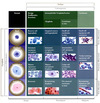Uterine Bleeding, PID, and Uterine Fibroids Flashcards
Medical burden of abnormal uterine bleeding
- Accounts for 70% of all GYN visits for peri- and post-menopausal women
- May occur at any age, but most densely in 5 years before menopause
“Normal” menses characteristics
- ~30 cc of blood lost
- Over the course of 4-6 days
- Some abdominal cramping and associated symptoms during this time, and symptoms should be relatively consistent from one menses to the next
Mnemonic for causes of abnormal menstruation
- PALM COEIN
- Polyps
- Adenomyosis
- Leiomyoma
- Malignancy
- Coagulopathy
- Ovarian dysfunction
- Endometrial process
- Iatrogenic
- Not yet classified
First steps if something abnormal is noted on pelvic exam, or if patient declines pelvic exam, when presenting with abnormal uterine bleeding
Pelvic ultrasound
Options for patients with anovulatory uterine bleeding unassociated with coagulopathy
- Oral contraception
- Cyclic progesterone
- Levonorgestrel IUD
- Endometrial ablation (requires endometrial biopsy first)
Options for long-acting reversible contraception with mechanisms

Uterine fibroid
Fibroids and leiyomyomata are the same!
They are benign, hormonally responsive tumors, whose growth is stimulated by estrogen. High estrogen states predispose to fibroid development (pregnancy, being on the pill, etc). In most persons with a uterus, they are asymptomatic, but they may cause heavy periods, pelvic pressure, and dysmenorrhea/uncomfortable menses.
Diagnosed by physical exam w/ supportive findings from imaging studies (usually pelvic ultrasound). If asymptomatic, no treatment necessary. If heavy bleeding is the only symptom, oral contraceptive, progestins, prostaglandin synthesis inhibitors (NSAIDs), and GnRH agonists (the latter for short term only). If more severe, uterine artery embolization, surgical myomectomy, or surgical hysterectomy are options.
How do we describe the size of the uterus on exam?
- In relation to size associated with # of weeks pregnancy
- In relation to finger breadths beneath the umbilicus
Who should you not give the oral contraceptive pill to?
Patients over age 35 with untreated hypertension, history of stroke or otherwise hypercoagulatility, history of migraines.
Uterine artery embolization
Minimally invasive interventional radiology procedure for devascularizing uterine fibroids.
Catheter is inserted into the femoral artery, then pushed up into the uterine artery. Local embolism of tiny spheres causes partial vascular occlusion, decreasing the local blood supply by just enough to prevent fibroid growth and development.
This option is safe and effective, but choice of eligible patients is very careful.
Ligaments of the uterus
- In order to accomadate the function of the uterus, some of these ligaments need to be flexible and adaptable
- The round ligament is mostly smooth muscle
- The broad ligament is loose araeolar tissue
- Thus, they are functional and do not provide the typical structural support of classic ligaments.
- The cardinal and uterosacral ligaments are true ligaments
- The cardinal, uterosacral, and round ligaments are all contained within the broad ligament
Risk factors of pelvic floor insufficiency
- Multiparity (giving birth to more than one at a time)
- Delivery of large babies
- Chronic increased abdominal pressure (coughing, weight lifting)
What vessel is closest to the sites of incision for inferior laporoscopic procedures?
The inferior epigastric artery, which branches off of the external iliac and comes in close proximity to the anterior abdominal wall

Patient presents with unexectedly early delivery and is already in substantial dilation. There is no time for a spinal block for the pain. What alternative approach can you use in this acute setting, and how does it work?
- A pudendal nerve block
- Find the ischial spine, then find your target point 1 cm inferior and 1 cm medial to the ischial spine
- Aspirate at this point first to ensure you are not injecting into the pudendal artery and inferior gluteal artery at this level

The most common site for an ectopic pregnancy
Within the fallopian tube proximal to the ovary and opening to the peritoneum
Why are males more likely to have venous backup in the left testicle than the right testicle?
Because the left gonadal vein must drain into the left renal vein and is in a more dependent position relative to other abdominal arterial structures, while the right renal vein drains directly into the IVC and is not closeby to any large, high pressure arterial stuctures which may occlude it.
Keep in mind nutcracker syndrome as a specific example

Vascular supply of ureter
- Vascular supply of the ureter depends on which ureter segment you are talking about!

Most common bacterial STI
Chlamydia
Basic C. trachomatis micribiology
- Obligate intracellular bacterium
- Closer related to gram +. BUT, unusual in that it has no peptidoglycan and has LPS instead, features more like gram -. As a consequence:
- C. trachomatis does not stain on gram stain
- C. trachomatis is not susceptible to beta lactams or vancomycin











